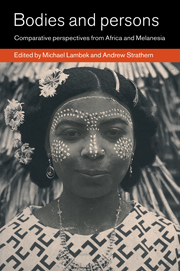Book contents
- Frontmatter
- Contents
- List of illustrations
- List of contributors
- Acknowledgments
- 1 Introduction: Embodying sociality: Africanist–Melanesianist comparisons
- Part I Transcending dichotomies
- Part II Transitions, containments, decontainments
- Part III From exchange to history
- 9 Creative possessions: spirit mediumship and millennial economy among Gebusi of Papua New Guinea
- 10 Dis-embodiment and concealment among the Atbalmin of Papua New Guinea
- 11 Melpa and Nuer ideas of life and death: the rebirth of a comparison
- 12 Afterword: embodying ethnography
- Bibliography
- Index
11 - Melpa and Nuer ideas of life and death: the rebirth of a comparison
Published online by Cambridge University Press: 05 June 2012
- Frontmatter
- Contents
- List of illustrations
- List of contributors
- Acknowledgments
- 1 Introduction: Embodying sociality: Africanist–Melanesianist comparisons
- Part I Transcending dichotomies
- Part II Transitions, containments, decontainments
- Part III From exchange to history
- 9 Creative possessions: spirit mediumship and millennial economy among Gebusi of Papua New Guinea
- 10 Dis-embodiment and concealment among the Atbalmin of Papua New Guinea
- 11 Melpa and Nuer ideas of life and death: the rebirth of a comparison
- 12 Afterword: embodying ethnography
- Bibliography
- Index
Summary
In this chapter we assist in resuscitating a comparison lost to anthropology for some time, the axis of comparison between Africa and Melanesia. We move from a narrative exposition of our theme of compensation and exchange among the Melpa of Papua New Guinea to a more general rendering of its underlying logical components, then we detail the colonial impact on compensation payments in the Melpa case, and finally we specifically compare Melpa materials with those on the Nuer people of the Sudan, described long ago by Evans-Pritchard (1940, 1951, 1956), and more recently by Sharon Hutchinson (1996).
Our Melanesia/Africa comparison has a double historical dimension. The first relates to the 1960s when Evans-Pritchard's model of Nuer social structure was initially taken as the blueprint for studies of “lineage systems” in the New Guinea Highlands and then in short terms rejected after the work of Barnes (1962). The second dimension belongs to the 1990s, when Hutchinson's study of the Nuer enables us to establish cultural correspondences and differences between the Melpa and the Nuer across a range of variables through its engagement with the topic of this volume, bodies and persons, or more accurately the embodiment of sociality.
Equivalence and substitution
What is a life worth? In the course of their history the peoples of the New Guinea Highlands elaborated a series of answers to this question. In the simplest of answers, a life is worth another life, in the sense that the killing of a person demanded a retaliatory killing.
- Type
- Chapter
- Information
- Bodies and PersonsComparative Perspectives from Africa and Melanesia, pp. 232 - 251Publisher: Cambridge University PressPrint publication year: 1998
- 3
- Cited by



